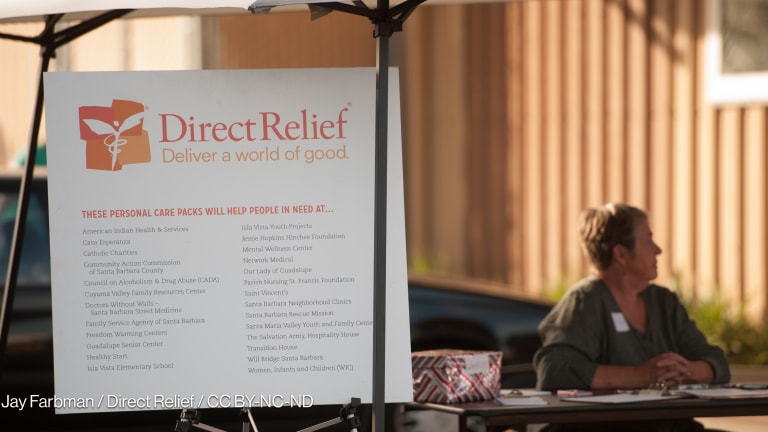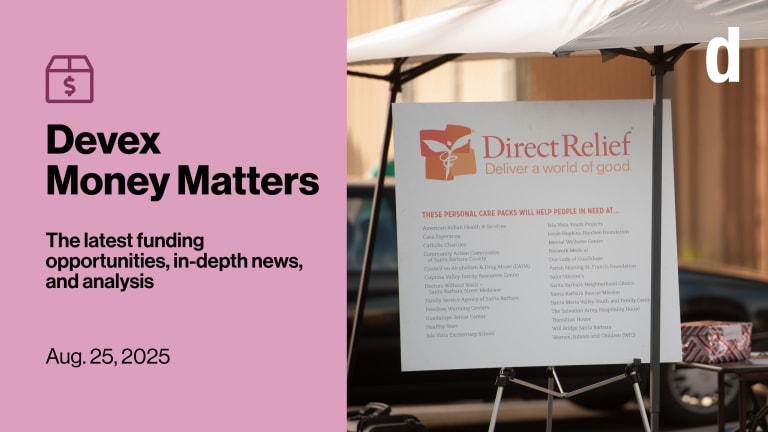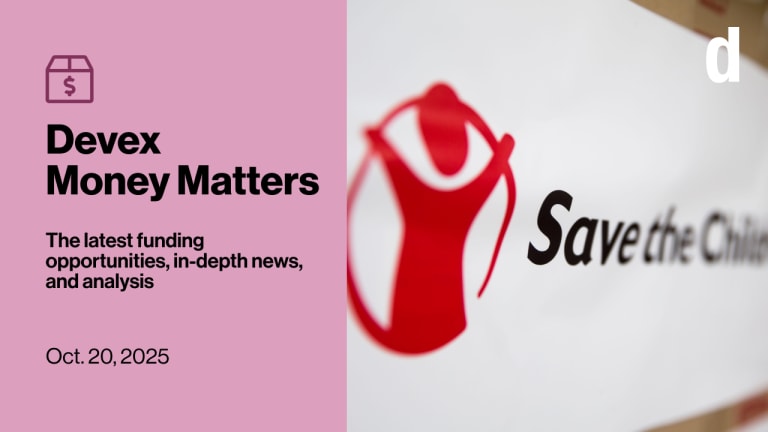The 50 largest US INGOs — and where they get their money
The 50 largest US INGOs reported a total income of $23.3 billion in their most recent filing — making their cumulative influence comparable to the world’s largest donors. But where do they get their money?
U.S.-based INGOs play an important role in the global development sphere. Just the 50 largest organizations in the sector spend more than $23 billion a year on development between them, making their cumulative influence comparable to the world’s largest donors. But who are they? How are they funded? And is their influence growing? We analyzed the most recent accounts, either 2021 or 2022, of the 50 largest U.S. INGOs, and we tracked their total income and sources of funding over the past five years. All figures were converted to 2021 constant prices. This allowed us to analyze the data in real terms, with respect to changes in inflation rates. We found that 37 of the 50 largest U.S. INGOs had higher incomes in real terms than they had five years ago — with government grants and other contributions, including funding from foundations and the public, as the leading sources of income for most. The top 50 INGOs reported a total income of $23.3 billion in their most recent filing. This represents a 16.8% increase from their $19.9 billion total income five years before — either 2017 or 2018. Year-on-year data during the first year of the pandemic also suggest a slight increase — from $21.2 billion in 2020 to $22.5 billion in 2021, or a 6.2% increase. Overall, these figures are largely in line with the wider growth of the U.S. economy. Who are the biggest INGOs by income? Direct Relief, which provides medical assistance and emergency relief globally, ranked first, with a $2.1 billion income in 2021. Catholic Relief Services ranked next, with $1.4 billion in 2022, followed by World Vision USA, with $1.3 billion in 2021, then Americares, with nearly $1.3 billion in 2022. The World Resources Institute saw the biggest growth within the five-year period — from $103.3 million in 2017 to $289.7 million in 2021, or a 180.3% increase. According to its financial statement, the bulk of its income in 2021 — around $210 million — came from foundations and contributions from foreign governments. Mercy Ships ranked next in terms of growth — from $78.8 million in 2017 to $212.7 million in 2021, or a 170% increase. Its income from contributions, gifts, and grants grew from $77.1 million in 2017 to $211.9 million in 2021. Next is Convoy of Hope; it saw a 125% increase — from $193.6 million in 2017 to $435.6 million in 2021. In-kind donation to Convoy of Hope has been increasing, reaching $314.8 million in 2021. Meanwhile, the data show that 13 organizations were better off five years ago than in their most recent filing. The following recorded the biggest dip: Management Sciences for Health — from $253.9 million in 2017 to $145.4 million in 2021, or a 42.7% decrease. Although its income from government grants increased — from $83.3 million in 2017 to $109 million in 2021, all the other contributions, gifts, and grants went down — from $151.3 million in 2017 to $36.3 million in 2021. Catholic Medical Mission Board — from $662.4 million in 2017 to $411.4 million in 2021, or a 37.9% decrease. Similar to MSH, CMMB’s dip in income was driven by fewer contributions, gifts, and grants — which accounted for nearly its entire income. DKT International — from $211.1 million to $141.8 million, or a 32.8% decrease. This was driven by a massive decline in program service revenue — from $161.1 million in 2017 to $5.7 million in 2021. Revenue from selling goods — primarily contraceptives — was able to offset this loss. Where do INGOs get their income? Our primary information on NGOs came from federal form 990 — an annual return filed by tax-exempt organizations. In the 990s, revenues — both cash and noncash — are classified into four top-level categories. The largest category is “contributions, gifts, and grants,” which is subdivided into six types. • Federated campaigns — or income from solicitation campaigns conducted by federated fundraising agencies. • Membership dues — which are membership payments from the public. • Fundraising activities — which include revenues from auctions, dinners, and similar events. • Related organizations — or contributions from affiliated organizations. • Government grants — which include contributions from both domestic and foreign governments. • All other contributions, gifts, grants, and similar amounts not included above — which include donor-advised funds, gaming activities, and other sources not included in any of the aforementioned. The category includes two very large sources for INGOs: grants from foundations and donations from the general public. The next largest category is “program service revenue,” which refers to money paid to an organization for services they provide. In many cases, this comes from government contracts for services that benefit them rather than the public. Two other smaller categories are investment income — which includes dividends, interest, and tax-exempt bond proceeds — and other revenues, such as royalties and rentals. INGOs appear to get their money almost exclusively from three sources. In order of size, these are: the public, the government, and foundations. All but one of the INGOs that we analyzed reported that more than half of their income in the five-year period came from contributions, gifts, and grants. Income from “all other contributions” and government grants were the top sources of revenue for most of the organizations we analyzed. Just looking at their most recent filing, 43 organizations reported that over 90% of their revenue came from contributions, gifts, and grants, while six organizations reported receiving more than 50% from the same source category. The exception is DKT International. More than half of its income in 2021, worth $72.6 million, came from sales of low-cost contraceptives — which was reported under “Other Revenues.” In total, the catch-all “other contributions” category accounted for $15.3 billion of INGOs’ 2021 income — 70.2% of all INGOs’ income. It is not recorded how this breaks down into public donations, bequests, and foundation grants. An analysis of all U.S. giving suggests public donations and bequests are worth around four times as much as foundation donations, with a small amount of additional contribution from corporations. However, foundations are known to allocate proportionately more of their giving to international development than the public, partly down to the oversized impact of the Bill & Melinda Gates Foundation. A rough estimate could be that around half of all the income of the largest NGOs comes from the general public, while around a sixth of all funding comes from foundations and most of the rest from the government. Around 36 organizations saw an increase in all other contributions in the five-year period. The International Medical Corps’ almost tripled its income from all other contributions — from $22 million in 2018 to $86.5 million in 2022. Then WRI, from $88 million in 2017 to $278.7 million in 2021; One Acre Fund, from $50.3 million in 2017 to $129.4 million in 2021; and the U.S. Committee for Refugees and Immigrants, from $1.7 million in 2017 to $4.3 million in 2021. Meanwhile, 27 organizations saw an increase in government grants in the five-year period. Americares had the biggest rise — from just $151,000 in 2018 to $12.7 million in 2022, or more than an 8,300% increase. Then the Rotary Foundation, from $556,000 in 2017 to $3.8 million in 2021; ADRA International, from $25.4 million in 2017 to $92.5 million in 2021; and Convoy of Hope, from $1.3 million in 2017 to $3.8 million in 2021. According to the most recent filings, 17 organizations reported that more than half of their revenue came from government grants. The National Democratic Institute recorded the highest proportion — with $136.5 million, or 96.8% of its total income in 2021 from government grants. According to its financial statement, NDI received $69.2 million from the U.S. Agency for International Development and $28.8 million from the State Department in 2021. The others include USCRI, with $117.4 million, or 94.1% of its total income; Pact, with $154 million, or 88.4% of its total income in 2021; and Orbis International, with $314 million, or 86.5% of its total income in 2021. Meanwhile, 31 organizations reported that more than half of their revenue came from all other contributions. Direct Relief had the highest proportion, with nearly $2.1 billion, or 99.8% of its total income in 2022 from all other contributions. According to its consolidated financial statements, Direct Relief received over $2 billion worth of pharmaceuticals, medical supplies, and other related products. The others include Christian Aid Ministries — with $161 million, or 99.8% of its total income in 2021; MAP International — with $819 million, or 99.6% of its total income in 2021; and Feed the Children, with $357.4 million, or 99.6% of its total income in 2022. How we collected and analyzed the data INGOs report their financial standing to the U.S. Government through federal form 990 — an annual return filed by tax-exempt organizations. These documents can be accessed through a range of sources, including the INGOs’ websites, the U.S. Internal Revenue Service, and other nonprofits such as ProPublica. While the information is public, these sources do not provide a list of organizations by income. Instead, we used a list of the top U.S. INGOs in FY 2020-21 produced using the now-defunct Open990.org as a guide. This list includes organizations that give their primary area of operation as international, but excludes those which do not spend most of their income in low- and middle-income countries, as well as organizations that have their primary office outside the United States. We took the top 100 organizations from that list and collected their most recent information — for either 2021 or 2022. From there, we came up with our own list of the 50 biggest INGOs. This means that some organizations that saw a significant increase in their most recent income but were not part of the previous list might have been excluded from the analysis. In particular, this excluded a number of large international bodies, which are headquartered in Switzerland but file revenue information in the U.S. Mostly notable, we excluded Gavi, the Vaccine Alliance, from the analysis, as its total revenue — worth $16.4 billion in 2021 — was heavily boosted by contribution to the COVAX facility and would inevitably skew all the other figures. Update, Aug. 2, 2023: This article has been updated to reflect the correct name of Church World Service in the charts. Try out Devex Pro Funding today with a free five-day trial, and explore funding opportunities from over 850 sources in addition to our analysis and news content.
U.S.-based INGOs play an important role in the global development sphere. Just the 50 largest organizations in the sector spend more than $23 billion a year on development between them, making their cumulative influence comparable to the world’s largest donors.
But who are they? How are they funded? And is their influence growing?
We analyzed the most recent accounts, either 2021 or 2022, of the 50 largest U.S. INGOs, and we tracked their total income and sources of funding over the past five years.
This story is forDevex Promembers
Unlock this story now with a 15-day free trial of Devex Pro.
With a Devex Pro subscription you'll get access to deeper analysis and exclusive insights from our reporters and analysts.
Start my free trialRequest a group subscription Printing articles to share with others is a breach of our terms and conditions and copyright policy. Please use the sharing options on the left side of the article. Devex Pro members may share up to 10 articles per month using the Pro share tool ( ).
Miguel Tamonan is a Senior Development Analyst at Devex, where he analyzes data from public and private donors to produce content and special reports for Pro and Pro Funding readers. He has a bachelor’s degree in Political Science with a Major in International Relations from the Polytechnic University of the Philippines.








